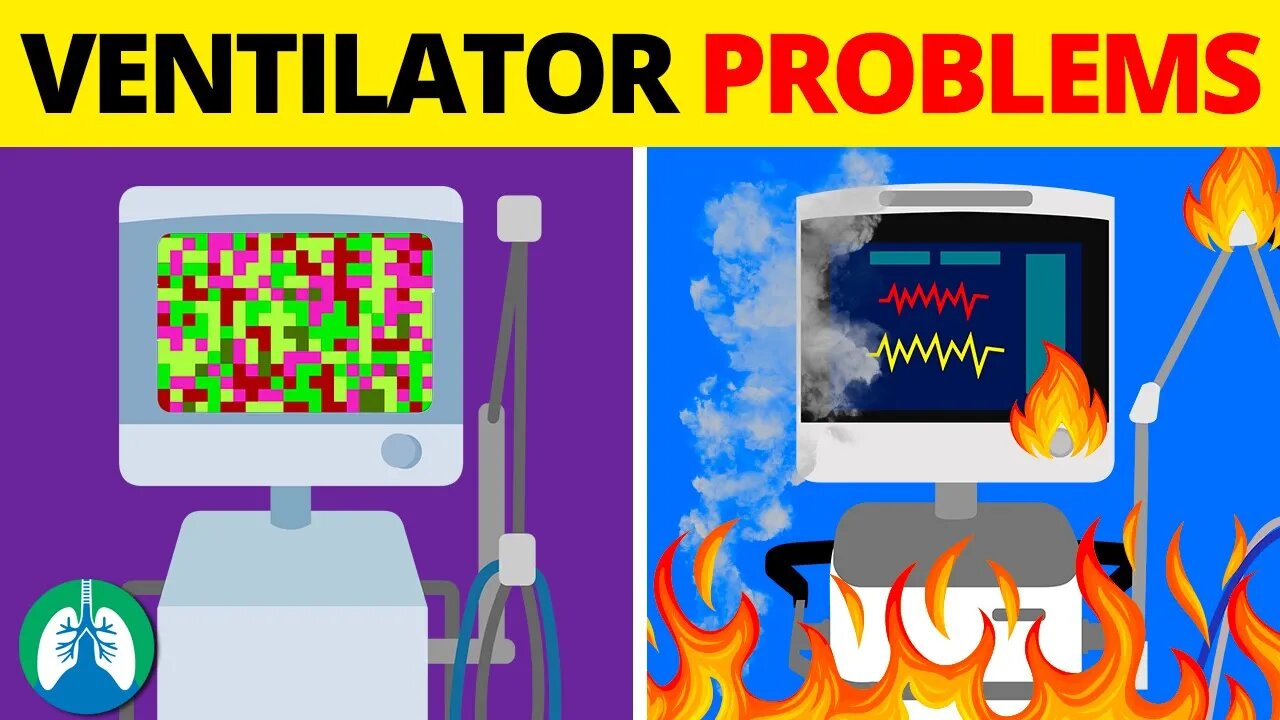Premium Only Content

Top 10 Problems During Mechanical Ventilation ⛔️
What problems can occur during mechanical ventilation? How can a respiratory therapist help troubleshoot these problems? Watch this video to find out!
💥Ventilator Troubleshooting [Full Guide] ➜ ➜ ➜ https://bit.ly/36i5YUH
➡️ Ventilator Troubleshooting
Ventilator troubleshooting is the process of identifying and solving a problem that occurs in the patient-ventilator connection. This is important because, when a problem occurs, it can cause the patient to experience discomfort or even put their life at risk. The goal of ventilator troubleshooting is to quickly identify the problem and then take the necessary steps to solve it.
➡️ Mechanical Ventilation Problems
In a perfect world, the delivery of mechanical ventilatory support would be flawless, and we would never experience any problems. However, of course, this is not the case.
➡️ Respiratory Distress
When a patient on the ventilator experiences a problem, one of the first signs you’ll see is respiratory distress. This includes signs and symptoms, such as:
- Tachypnea
- Tachycardia
- Nasal flaring
- Diaphoresis
- Paradoxical thoracic movement
- Arrhythmias
- Dyspnea on exertion
- Accessory muscle usage
- Pursed-lip breathing
➡️ Ventilator Alarms
Ventilator alarms serve as a safety mechanism and use a set of parameters to provide alerts whenever a problem arises in the patient-ventilator interaction. There are several different types of alarms that may sound whenever a problem arises, including:
- High pressure
- Low pressure
- Low volume
- High frequency
- Apnea
- High PEEP
- Low PEEP
➡️ System Leaks
A system leak occurs when there is a disconnection, a problem with the circuit, or a problem with the artificial airway. Some signs of a leak during mechanical ventilation include:
- Low pressure alarm
- Low volume alarm
- Low minute ventilation alarm
- Abnormal ventilator graphics
If the leak is due to a disconnection, you’ll simply need to reconnect the circuit. If the problem is with the artificial airway, you may need to check the cuff pressure and add more air to the cuff. Otherwise, you’ll need to replace the artificial airway.
➡️ Inadequate Oxygenation
If the patient is not receiving enough oxygen, the low-SpO2 alarm will sound. In this case, an arterial blood gas (ABG) should be analyzed to confirm that hypoxemia is present. Then you can adjust the FiO2 or PEEP settings accordingly, depending on the patient’s needs. Refractory hypoxemia is another oxygenation problem that can occur during mechanical ventilation in severe cases. This is when the patient’s SpO2 doesn’t increase despite a high FiO2 setting. This is often a sign of acute respiratory distress syndrome (ARDS) and requires treatment with high levels of PEEP.
➡️ Patient-Ventilator Asynchrony
Ventilator dyssynchrony is characterized by inappropriate timing of a delivered breath between a patient and the mechanical ventilator. This increases the work of breathing and makes it more difficult for the patient to breathe comfortably on the machine.
💥Ventilator Troubleshooting [Full Guide] ➜ ➜ ➜ https://bit.ly/36i5YUH
—————
📗 BEST STUDY GUIDES FOR YOU
▪ TMC Test Bank 👉 http://bit.ly/2IGeqSu
▪ Hacking the TMC Exam 👉 http://bit.ly/2XBc8do
▪ TMC Exam Bundle (Save $) 👉 https://bit.ly/34pqEsV
▪ Daily TMC Practice Questions 👉 http://bit.ly/2NnXh3C
💙MORE FROM RTZ
▪ Free TMC Practice Exam 👉 http://bit.ly/2XlwASL
▪ Free RRT Cheat Sheet 👉 http://bit.ly/2IbmOKB
▪ Resources for RT's 👉 http://bit.ly/2WVV5qo
▪ Testimonials 👉 http://bit.ly/2x7b5Gl
🌐FOLLOW US
▪ Instagram 👉 http://bit.ly/2FhF0jV
▪ Twitter 👉 http://bit.ly/2ZsS6T1
▪ Facebook 👉 http://bit.ly/2MSEejt
▪ Pinterest 👉 http://bit.ly/2ZwVLPw
🚑MEDICAL DISCLAIMER
This content is for educational and informational purposes only. It is not intended to be a substitute for professional medical advice, diagnosis, or treatment. Please consult with a physician with any questions that you may have regarding a medical condition. Never disregard professional medical advice or delay in seeking it because of something you watch in this video. We strive for 100% accuracy, but errors may occur, and medications, protocols, and treatment methods may change over time.
💡AFFILIATE DISCLAIMER
This description contains affiliate links. If you decide to purchase a product through one of them, we receive a small commission at no cost to you.
—————
⏰TIMESTAMPS
0:00 - Intro
0:33 - Ventilator troubleshooting
1:13 - Mechanical Ventilation Problems
1:22 - Respiratory Distress
2:01 - Ventilator Alarms
2:45 - System Leaks
3:30 - Inadequate Oxygenation
4:21 - Patient-Ventilator Asynchrony
5:10 - Artificial Airway Problems
5:54 - Secretion Buildup
6:39 - Auto-PEEP
7:12 - Accidental Extubation
—————
🖼CREDIT FOR MUSIC AND GRAPHICS:
▪ Music licensed from Audiojungle.net/
▪ Graphics: Canva.com, Freevector.com, Vecteezy.com, and Pngtree.com
#RespiratoryTherapy #RespiratoryTherapist #mechanicalventilation
-
 4:01
4:01
Respiratory Therapy Zone
1 year agoLung Lobes and Fissures *EXPLAINED* 🫁
399 -
 1:15:07
1:15:07
Ami's House
19 hours ago $9.57 earnedWhat an ACTUAL Military Expert Thinks of the War in Gaza – Nick Freitas | FULL EP
30.6K22 -
 2:54:02
2:54:02
TimcastIRL
11 hours agoLiberal Media CAUGHT In BOGUS LEAK, Trump DID NOT Fire Mike Waltz, HE PROMOTED HIM | Timcast IRL
237K132 -
 9:05:24
9:05:24
MyronGainesX
18 hours ago $28.08 earnedSam Seder Embarrasses Ethan Klein, The Truth On MLK's Murder, Panel Debate w/ Anton Daniels
86.2K25 -
 1:09:38
1:09:38
Man in America
14 hours agoEXPOSED: How Militaries Worldwide Are Engineering DEPOPULATION w/ Todd Callender
81.4K53 -
 8:00:02
8:00:02
SpartakusLIVE
12 hours agoNEW Update, NEW Weapons, NEW META?!? || Quads in VERDANSK
38.6K -
 5:14:28
5:14:28
Jokeuhl Gaming and Chat
10 hours agoEmpyrion - Galactic Survival Long Range Jump Aquired
50.1K1 -
 4:42:30
4:42:30
Right Side Broadcasting Network
1 day agoLIVE REPLAY: President Trump Gives Commencement Address at University of Alabama - 5/1/25
175K23 -
 16:58
16:58
T-SPLY
16 hours agoDems’ Bad News: El Salvador Rejects Abrego, Democrats Fume!
117K67 -
 18:56
18:56
Nick Shirley
12 hours ago $7.60 earnedAsking People About Trump’s First 100 Days… How are Americans Feeling?
49.7K58